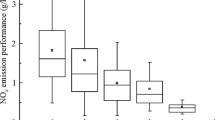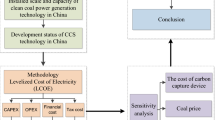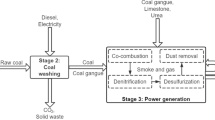Abstract
This study comprehensively assessed the technological options for reducing SOx and CO2 emissions in northeastern China’s electric power sector with the linear programming models that take into consideration technological and regional characteristics in detail. We assessed the options for existing coal-fired power plants in the static analysis and the options for new ones in the dynamic analysis. According to the results, coal washing and flue gas desulfurization (FGD) are superior in reducing SOx, but they cannot reduce CO2 sufficiently. Natural gas and nuclear power are superior in reducing CO2, and SOx is reduced dramatically by them as well. Integrated gasification combustion cycle (IGCC) and pressurized fluidized bed combustion (PFBC) have large emissions reduction potential but are inferior in terms of cost. Supercritical unit and wind power are relatively superior in reducing CO2. The optimal composition of power plants and the assessment of photovoltaic (PV) power depend on the shape of the daily load curve. PV is much inferior to other options in reducing SOx and CO2. In addition, the avoided capacity by introducing PV is very small. The results imply that accelerating the utilization of coal washing and FGD should be given greater emphasis in China. It is also suggested that China could reduce SOx economically by introducing natural gas, IGCC, or PFBC as the measures for CO2 reduction through such frameworks as the clean development mechanism.
Similar content being viewed by others
References
Asian Development Bank (1997) Electric utilities data book. Asian Development Bank, Manila, pp 471
Chandler W, Guo Y, Logan J, Shi Y, Zhou D (1998) China’s electric power options: an analysis of economic and environmental costs. Battelle Memorial Institute, Washington, DC
China environmental statistics (1996, 1998) (in Chinese). China Statistical Publishing House, Beijing
Ebata S (1997) Energy consumption and air pollution control in East Asian countries (in Japanese). NISTEP research material report no. 51. National Institute of Science and Technology Policy, Tokyo
Fujii Y, Yamaji K (1998) Assessment of technological options in the global energy system for limiting the atmospheric CO2 concentration. Environmental Economics and Policy Studies 1:113–139
Imamura E, Uchiyama Y (1994) Market penetration analysis of dispersed generation technologies and development of economic simulation model for photovoltaic system (in Japanese). Report no. Y93009. Socio-economic Research Center of Central Research Institute of Electric Power Industry, Tokyo
Imanaka T, Yamaji K (2001) Power system modeling with coal transportation for Shandong, China (in Japanese). In: Proceedings of the 17th conference of energy, economy, and environment. Japan Society of Energy and Resources, Osaka, pp 519–524
Japan Electric Power Information Center (JEPIC) (2000) Overseas electric power industry statistics (in Japanese). Japan Electric Power Information Center, Tokyo, pp 119–139
Japan Society of Energy and Resources (1996) Energy and resources handbook (in Japanese). Ohm-sha, Tokyo, pp 537–540
Japan Solar Energy Society (1985) Solar energy utilization handbook (in Japanese). Japan Solar Energy Society, Tokyo, pp 1–45
JCOAL (1999) Survey of coalmine in the world (in Japanese). JCOAL, Tokyo, pp 117–179
Ministry of Electric Power (MEP) (1996) Electric power industry in China. China Electric Power, Beijing
Nakashima M (1997) Institutions for managing environment and measures for abating air pollution in China (in Japanese). Hiroshima International Studies 3:139–155
NEDO (1995a) Environmentally-friendly coal utilization system feasibility survey in the coal industrial sector in China (in Japanese). Report no. NEDO-C-9415. NEDO, Tokyo
NEDO (1995b) Cooperative demonstration project of water-saving coal washing system (in Japanese). Report no. NEDO-C-9438. NEDO, Tokyo
NEDO (1996) Environmentally-friendly coal utilization system feasibility survey in the coal washing sector in China (in Japanese). Report no. NEDO-C-9538. NEDO, Tokyo
NEDO (1998) Survey of the trend of coal washing technology in China (in Japanese). Report no. NEDO-C-9708. NEDO, Tokyo
NEDO (2000) A study on the method to estimate wind power and solar power in developing countries such as Myanmar (in Japanese). Report no. NEDO-T-99064. NEDO, Tokyo
Nishio K, Saisyo Y, Yamaji K, Fujii Y (2002) An effect of RPS, the policy for the promotion of the renewable energy (in Japanese). In: Proceedings of the 18th conference of energy, economy, and environment. Japan Society of Energy and Resources, Osaka, pp 507–512
Ohtani K, Sakuta K, Kato K, Sugiura T, Uchida D, Yamaguchi T, Kurokawa K (2000) Operating performance analysis of residential photovoltaic systems in Japan (in Japanese). Presented at the study meeting of frontier technology and engineering, Power and Energy Society, Institute of Electrical Engineers of Japan. Paper FTE-00-5. Institute of Electrical Engineers of Japan, Tokyo
Sadakata M (1997) Environmental problem in developing countries and new engineering (in Japanese). Presented at The Century of Environment meeting, Tokyo
Souken (1999) Chugoku furyoku (in Japanese). Kanki Shuppan, Tokyo
Sugiyama T (1999) Development of China provincial energy and emissions model (in Japanese). Report no. Y98009. Socio-economic Research Center of Central Research Institute of Electric Power Industry, Tokyo
Takahashi M, Nagata Y, Uchiyama Y (1996) Analysis of optimal planning for power generating system under the constraint on CO2 emissions (in Japanese). In: Proceedings of the 15th presenta-tion party of the Japan Society of Energy and Resources. Japan Society of Energy and Resources, Osaka, pp 191–196
Tozai Boueki Tushin-sha (1999) Electric power industry in China (in Japanese). Tozai Boueki Tushin-sha, Tokyo
Yajima K, Kaya Y (1994) Total assessment of the economy of photovoltaic power generation (in Japanese). In: Proceedings of the 13th presentation party of the Japan Society of Energy and Resources. Japan Society of Energy and Resources, Osaka, pp 307–312
Zhou D, Guo Y, Shi Y, Chandler W, Logan J (2000) Developing countries and global climate change: electric power options in China. Pew Center on Global Climate Change, Arlington, VA
Author information
Authors and Affiliations
About this article
Cite this article
Takeshita, T., Yamaji, K. Assessment of electric power options for reducing SOx and CO2 emissions in northeastern China. Environ Econ Policy Stud 5, 63–103 (2002). https://doi.org/10.1007/BF03354024
Received:
Accepted:
Published:
Issue Date:
DOI: https://doi.org/10.1007/BF03354024




